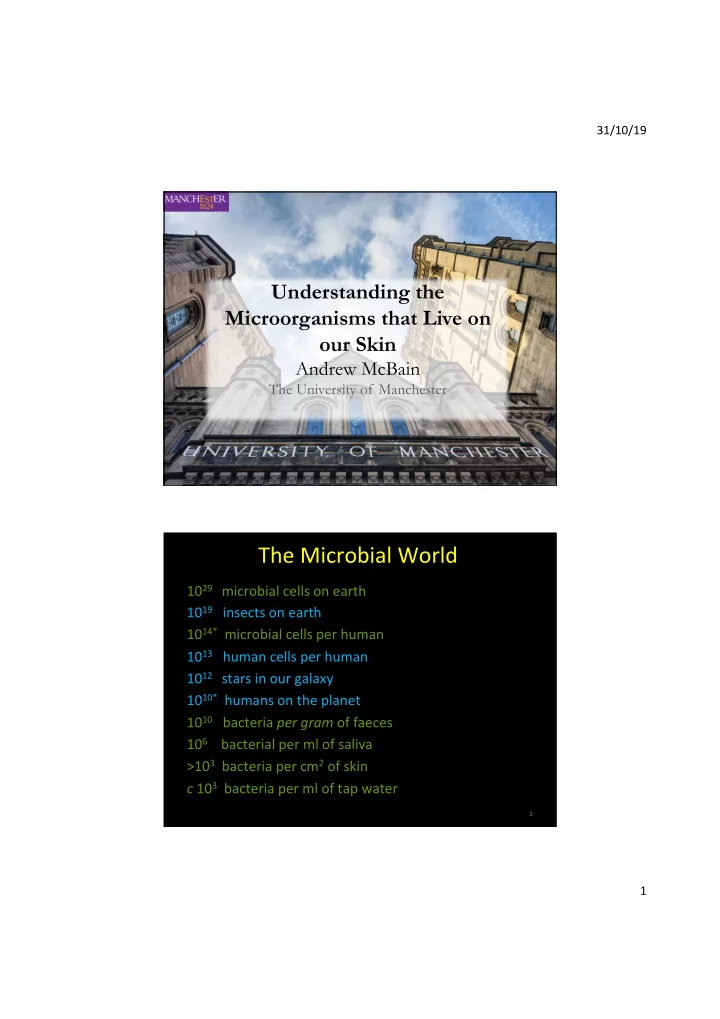

31/10/19 Understanding the Microorganisms that Live on our Skin Andrew McBain The University of Manchester 1 The Microbial World 10 29 microbial cells on earth 10 19 insects on earth 10 14* microbial cells per human 10 13 human cells per human 10 12 stars in our galaxy 10 10* humans on the planet 10 10 bacteria per gram of faeces 10 6 bacterial per ml of saliva >10 3 bacteria per cm 2 of skin c 10 3 bacteria per ml of tap water 2 1
31/10/19 The Human Microbiome Many (if not most) bacteria that associate with mammals do so as (mostly) sessile microbial communities • Oral • Nasal • Skin Micro flora / Microbiota / Microbiome • Genitourinary • Intestinal 3 The traditional method 4 2
31/10/19 The microbiota- traditional view 5 Microbial inhabitants of humans. Michael Wilson Cambridge University Press, 2005. Next generation sequencing 6 3
31/10/19 The microbiome- current view • The composition of the microbiome varies by anatomical site • The primary determinant of community composition is anatomical location: • Interpersonal variation is substantial and is higher than the temporal variability seen at most sites in a single individual. • Minor perturbations such as dietary changes can rapidly cause substantial intestinal metagenomic changes - Nasopharyngeal microbiota in children varies seasonally - Vaginal microbiota varies with menses - Oral microbiota varies with hygiene/diet • Microbiota composition is extensively conserved at high taxonomic levels • Variation increases at lower taxonomic levels • 85% of the sequences obtained from the distal gut of the mouse represent genera that are not detected in humans Cho and Blaser (2012) The Human Microbiome: at the interface of health and disease. Nat Rev Genet 7 13(4): 260–270 8 4
31/10/19 The colonic microbiota- very heavily studied What is known about gut microbiota? • Ancient origins of symbiosis • c 10 14 bacteria in the human gut i.e. 100,000000,000000 • Colonisation begins at birth • Stable dominant biota • Chemotherapeutic agents disrupt balance of biota • Microbiota involved in drug metabolism • A metabolic organ Thanks to George Macfarlane 9 Microbial gas metabolism in the colon Carbohydrate Excretion (breath)/flatus Fermentation H 2 S u l p h a t e r e d u c i n g b a c t e r i a H 2 S SO 4 2- Acetogenic bacteria CH 3 COOH CO 2 VFA/SCFA Methanogenic bacteria CH 4 10 5
31/10/19 11 Bacteria living on the skin The Skin Microbiome 6
31/10/19 Topographical distribution of bacteria on skin sites Grice and Segre, 2011 7
31/10/19 Factors contributing to variation in the skin microbiome Grice and Segre, 2011 Functions Positive Negative Colonisation resistance Infection Immune modulation Implicated in a range of skin diseases Metabolism Metabolism Protection Barrier augmentation 8
31/10/19 Mapping the skin Bouslimani et al., 2014 Mapping the skin Bouslimani et al., 2014 9
31/10/19 What about aging? Here, we developed a method of predicting biological age of the host based on the microbiological profiles of gut microbiota using a curated dataset of 1,165 healthy individuals (3,663 microbiome samples). Our predictive model, a human microbiome clock, has an architecture of a deep neural network and achieves the accuracy of 3.94 years mean absolute error in cross-validation 10
31/10/19 Aging and the skin microbiome Dimitriu et al., 2019 11
31/10/19 12
31/10/19 Microbiome challenges and opportunities • Over-interpretation of data • Linking composition to function (e.g. what is dysbiosis?) • Understanding disease • Understanding health* • Manipulation for health benefits 25 13
Recommend
More recommend